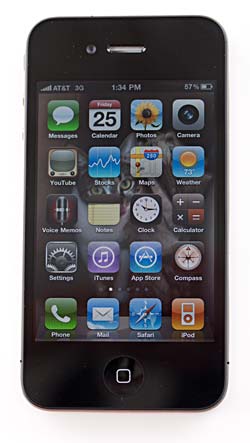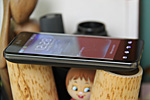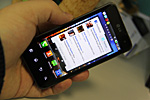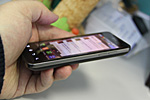Review LG Optimus 2x (P990) GSM/UMTS smartphone
Live photos of LG Optimus 2x
In the box
- Phone
- 1500 mAh Li-Ion battery
- Charger
- USB cable
- Wired stereo headset
- A CD with LG PC Suite
- User Guide
Positioning
In 2010 Samsung chose Android models as their priority and paid special attention to its flagship Galaxy S. After its sales started the model became extremely popular and around 10 million items were shipped rather quickly, which is a sensation for the price segment. We do not take Apple iPhone into equation as it is unique and follows other rules with constant demand on the market. LG could not offer a single model to rival Samsung Galaxy S in 2010. As far as the company targeted Android as well and managed to become successful in mid-price segment with its Optimus line the absence of a flagship was a problem. Every company needs not only millions of sold phones, but the revenues too. Flagship models offer maximum margins and provide considerable profits even if you don't sell many items. Apple shows that by controlling a mere 3% of the market you can earn more than the big three (Nokia, Samsung, LG) who can boast of combined 70% of the market.
In 2011 LG will target the increase of its average model price, which is impossible without expensive flagships. LG understood it well before the reorganization started and quarter results went down. The development of Optimus 2x began in the first part of 2010 being aware that Samsung will launch Galaxy S soon and would dedicate all resources to the model LG decided to come out later, but be prepared for this tough competition.
The main issue is the absence of strong departments developing components for its models, for example screens, processors or memory. Many years ago LG decided not to concentrate on processors and memory, but they do make their own screens. LG even sells them to others and its screens can be found in some Apple devices. The quality is high, but LG could not compete with Samsung in terms of processors, so they needed an external partner in the shape of Nvidia, which was always popular as the manufacturer of graphic solutions. Two years ago Nvidia tried to enter the segment with Tegra and banked on the resurrection of Windows Mobile. It was a mistake as Microsoft started from scratch and Nvidia products were never released. Nvidia lost two years, but changed its priorities to Android. LG and Motorola became first and strategic partners. Both companies rely on SOC Tegra2 to compete with Samsung, which had different plans. At the same time Samsung started developing its own system named Onion. Qualcomm and Texas Instruments could not produce the goods in time and by choosing Nvidia LG and Motorola successfully won half a year of leadership.
LG use a better solution and they do it first. Huge sales of Optimus 2x are not an absolute priority. Consumers must understand that LG models can offer the latest technology. Optimus 2x will help other models in the Optimus line and showcase know-how available for LG. It is a win-win situation.

Surprisingly LG found a small segment of techies ready to pay premium prices for a revolutionary model boasting some cutting-edge features, for example, a dual core processor. Around 5 years ago the same approach helped Sony Ericsson make a breakthrough and increase its market share. Flagship models are expensive, but they advertise other solutions. This simple trick works every time and LG is not an exception here.
Mass market audiences are still not familiar with LG and even Samsung can be suspicious for some. People looking for flagship models are happy to buy Apple iPhone and see no alternatives. That is why the rest of the pack (Motorola, LG, Samsung, Sony Ericsson) get only the consumers who somehow failed to buy an iPhone. It is still a large slice of the pie though.
Optimus 2x is positioned as the leader not only for LG, but for the segment of flagships as well. LG can only emphasize its technological advantages, while the ease of use and other features will not be prominent. Mass market audiences will not pay attention to the handset despite the omnipresent advertisements. On the other hand the image of Android as the leading OS marries well with the LG flagship. The target was be hit well. Motorola helped LG too by retreating from the majority of European markets. ATRIX 4G will be available in USA, UK, Germany, Canada and may be Spain with Poland. Optimus 2x will do well in Korea and the rest of Europe.
Another question is the relations of this flagship with Optimus 3D. This is a variation of the original Optimus with two cameras for 3D video recording. I think this exotic product is far from the mass market. It is too much even for the techies. The same can be said about Samsung Android smartphones with in-built projectors. The sales have already started, but they failed to capture the imagination even in Korea. Optimus 3D will follow suit due to its features and the price.
Design, dimensions and controls
Optimus 2x was unveiled at CES 2011 during the press conference of Nvidia. Its CEO mentioned that the model has industrial design, which is true. It looks like any other rival handset. The build is excellent, but the front side of the model lacks any peculiarity. Do you remember a 3 meter rule from Motorola designers? At this distance people should guess the phone model. Unfortunately, even Motorola abandoned this rule. Look at pictures with Motorola ATRIX 4G at the forefront followed by LG Optimus 2x. Both handsets look similar. We cannot criticize LG for that as it is a general tendency nowadays. Both phones look the same.

The back panel is equally recognizable. A vertical metal element creates an illusion that the whole panel is made of metal, but it is only plastic. The cover is too thin, but fits well without any looseness.

The model weighs 144 g with the dimensions of 123.9х63.2х10.9 mm. It is quite heavy, but my HTC Desire offers 135 g, which is comparable. There is no much difference from rival models - Atrix 4G, Samsung Galaxy S, HTC Desire HD. You get accustomed easily and the phone fits any hand well. It is too broad though.
 LG Optimus 2x vs Samsung Galaxy S:
LG Optimus 2x vs Samsung Galaxy S:



 LG Optimus 2x vs HTC Desire:
LG Optimus 2x vs HTC Desire:




 LG Optimus 2x vs Apple iPhone 4:
LG Optimus 2x vs Apple iPhone 4:



At the back you have a slightly protruding camera and the handset usually rests on it. On sliding surfaces Optimus 2x can swing easily. Galaxy S sports an upturn at the bottom to prevent siding. Here the back cover is a good launching area for sending the phone falling down. Remember it when you put the phone on a closed laptop or car's dash-board.

The body is well-built, but uses plastic only. The sides have a metal resembling paint, but there is no metal here if you scratch the surface.

The front hosts a grilled speaker and the proximity sensor to the left with the frontal camera to the right. Below the screen are located four sensor keys. All manufacturers now get rid of hardware buttons, which is not convenient, but it is not a serious issue anyway.

Much has been said about the screen protecting plastic. If you look at the list of products on Gorilla Glass website you will not find Optimus 2x there, but if you analyze the features of the material you will end up with something very similar. It can't be scratched, but it is not protected from fingerprints by an oil-repellent surface.

On the right side we see a paired volume rocker, while the top hosts an on/off button responsible for unblocking the phone. A 3.5 jack and an HDMI are covered by plastic caps.

At the bottom we have a microUSB jack together with speakers. During the music playback only one speaker is in active use, but the sound will persist if you cover it with a finger. It becomes feebler, but comes from different sides. Developers managed to ensure that the phone will play music well in different environments.
Screen
After Samsung with Amoled and SuperAmoled technologies everybody tries to emulate them. LG uses a standard TFT matrix similar to several Samsung phones (Wave II, Galaxy S SuperClear TFT). In terms of marketing the screen is not a highlight and has no special name. Quality-wise this screen shows black as grey, which is visible in the menu with much background, but in real life you will not feel the difference. Moreover, this TFT screen offers comparable quality as SuperAMOLED from Galaxy S. The same happened with Wave II and Galaxy S. Test shots reveal that the color reproduction is almost identical. If you don't use a magnifying glass the picture quality will be the same.









A serious difference lies in the energy consumption, which is higher for TFT screens. According to specification SuperAmoled needs 50% of the power. Unfortunately, we cannot take screens out of handsets to compare operation times as any phone is a combination of a processor, memory, screen and so on. There are too many factors for straight comparisons. Nevertheless we carried out several tests. With the maximum brightness for both models we selected identical slideshow pictures. Samsung Galaxy S came out on top with the lead of 35%. Android 2.2 was used in both phones. In the second test we analyzed operation times during video playback (with DSP for video decoding). DSP can influence the outcome as better architecture can compensate inferior screen, but there was no place for a miracle and Samsung won again with 30%.

In fact we can claim that the energy consumption of its TFT screen is the weakest link in LG Optimus 2x.
We also decided to involve Galaxy S 9003 (SuperClear TFT) and carried out the second experiment with the slideshow. The results were different as the Samsung model was in front by only 6.5%. Galaxy S 9003 differs from the original Galaxy S only with its screen, so all developments are influenced by screen power consumption only.
Our experiments show that the picture quality can be the same, but other parameters can be quite different. In the battery section we will mention different power consumption modes.
The screen displays up to 16 million colors with the bright and condensed picture. Viewing angles are convenient, but in the sun the picture fades. There are no flares though. The screen is very close to Galaxy S.


You can customize fonts for a menu as this option is available from the settings. The default fonts allow for up to 14 text lines and several status lines. Fonts are large and easy to read.
The screen resolution is traditional 480х800 with the physical size of 4″ (52х88 mm).
Frankly speaking, we should compare Optimus 2x with Galaxy S2, which has SuperAMOLED Plus. It has even better energy consumption characteristics. These two models will be direct rivals.
Battery
The model comes equipped with a 1500 mAh Li-Ion battery identical to the one in Samsung Galaxy S, which allows carrying out a meaningful test. The results have been mentioned above in the screen section.

The manufacturer claims up to 11.5 hours of talktime (GSM) and up to 760 hours (30 days) on standby. To get the results you need ideal circumstances. The same applies to Galaxy S performance.
We tested both model in similar environments. During the music playback we used the same headphones, maximum volume and selected a cycle playback. Screens and equalizers were disabled, apps were not running in the background mode with the memory cards out (playback from the in-built memory). Optimus 2x offered 31 hours, while Samsung Galaxy S managed only 25 hours. Optimus 2x won by 24%.
During the video playback we used DVDRip with the following characteristics:
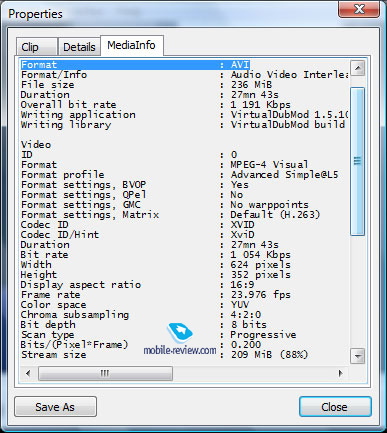
Results depended a lot upon screen settings. With the maximum brightness Samsung Galaxy S gave us around 5 hours, while Optimus 2x could produce only 3.5 hours. Automatic adjustment of brightness leveled the difference between the models, but still Galaxy S produced 5.6 hours, when Optimus 2x could come up only with 4 hours.
Data transfer via WiFi (files downloads through the links in indefinite mode with disabled screens) showed parity with both models working during the identical period of time.
3G (download of files in indefinite mode) offered the parity again (4.5 hours). The result depends on the network, coverage quality and phones interference. Interestingly, with the enabled screens the situation was different. The operation time went down by 1 hour and Samsung Galaxy S received an advantage due to lower energy consumption.
All these tests are not vital for consumers, because they don't tell you how long your sample will work in real life. My HTC Desire usually "dies" by 2 pm, while Galaxy S goes strong until the evening (7 pm). The standard workload is 1.5 hours of talktime, 20 SMS, more than 200 read messages, constant EDGE connection for mail, PUSH and Twitter clients. With this scenario I did not notice much difference from Galaxy S. I think it is quite an achievement as the computational power was boosted and it had to influence the power consumption, especially taking into account the type of screen used. Tegra2 allowed keeping this parameter decent.
Memory and memory cards
The handset has 8 GB of memory divided into two disks: a system one (1.5 GB) and another disk for user data (5.5 GB). Hot swappable microSD cards of up to 32 GB can be used as well. The slot is under the back cover. The model also boasts 380 MB of RAM with 110 MB free for users. It does not affect the performance and if necessary the memory can be freed.
Performance
All synthetic tests associated with the performance of Nvidia Tegra2 in comparison with modern flagships are in the separate article.
